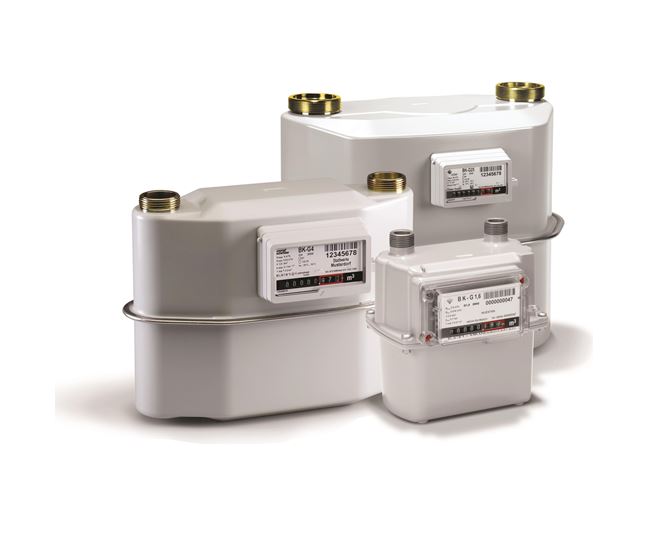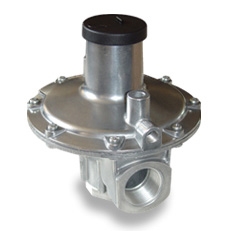Honeywell Spotlight

This April we are shining the spotlight on one of the leading worldwide metering manufacturers: Honeywell.
In this article we will be looking at the BK range of Gas Diaphragm meters, our newly awarded Platinum status and finally covering how to change the spring on a J48 regulator.
Demystifying the Mechanics: How Does the Elster Honeywell BK Gas Meter Work?
Gas meters are vital components in the infrastructure of modern society, quietly facilitating the flow of natural gas to homes, businesses, and industries. Among the array of gas meters available, the Elster Honeywell BK Gas meter stands out for its efficiency, accuracy, and reliability. But how does it work? Let's delve into the inner workings of this essential device.
The BK Gas meter is a mechanical meter designed to measure the volume of natural gas flowing through pipelines. Its operation relies on well-established principles of fluid mechanics and mechanics, combined with precision engineering to ensure accurate readings.
At its core, the BK Gas Diaphragm meter operates based on the principle of positive displacement. This means that it measures the volume of gas passing through it by capturing discrete volumes within its chambers and then tallying up these volumes to provide a total measurement.
Inside the meter:
Casing: The outer shell of the BK Gas meter provides protection to its internal components and also houses the mechanisms necessary for its operation. 
Rotors: Inside the meter, there are a pair of rotors positioned within cylindrical chambers. These rotors are shaped to fit snugly within the chamber and are free to rotate as gas flows through the meter.
Counting Mechanism: Connected to the rotors is a counting mechanism that tracks the rotations of the rotors. Each rotation corresponds to a specific volume of gas, and the counting mechanism accumulates these rotations to calculate the total volume of gas passing through the meter.
Operation Sequence
Gas Inlet: Natural gas enters the meter through an inlet port connected to the pipeline. As the gas flows into the meter, it encounters the rotors positioned within the chambers.
Rotor Rotation: The force of the gas flow causes the rotors to rotate. Each rotation displaces a fixed volume of gas, which is then trapped within the chamber.
Counting: As the rotors turn, they drive the counting mechanism, which records the rotations. This counting mechanism is calibrated to convert rotor rotations into volume measurements.
Gas Outlet: After passing through the chambers and driving the rotors, the gas exits the meter through an outlet port and continues its journey through the pipeline network.
Accuracy and Calibration
Ensuring the accuracy of gas meters is crucial for fair billing and efficient resource management. The Elster BK Gas meter undergoes rigorous calibration procedures to guarantee precise measurements. Calibration involves comparing the meter's readings against known standards and making adjustments as necessary to eliminate any discrepancies.
Maintenance and Longevity
To maintain optimal performance, regular maintenance of the Elster BK Gas meter is essential. This typically involves inspection for damage or wear, cleaning of internal components, and recalibration if needed. With proper care, these meters can provide years of reliable service, contributing to the seamless operation of gas distribution networks.
In essence, the Elster BK Gas meter is a marvel of engineering, blending mechanical ingenuity with scientific principles to accurately measure the flow of natural gas. From its sturdy casing to its precision rotors and counting mechanism, every component plays a vital role in ensuring accurate readings. As gas continues to be a cornerstone of energy supply worldwide, meters like the Elster BK Gas meter will remain indispensable tools for monitoring and managing gas consumption.
Understanding how these meters work not only fosters appreciation for the technology behind them but also highlights their importance in our daily lives. Whether it's heating our homes, powering our stoves, or fueling industrial processes, the Elster BK Gas meter quietly performs its duty, keeping the wheels of civilization turning smoothly.
Celebrating Excellence: DMS Metering Solutions Upgraded to Honeywell Platinum Distributor Status
We are thrilled to share some exciting news with our valued clients and partners. We have reached yet another milestone with our Industry leading partner – Honeywell. We have been awarded the prestigious Honeywell Platinum Distributor status! This upgrade from our previously held Gold Status is a testament to our unwavering commitment to quality, innovation, and customer satisfaction. 
Earning the Honeywell Platinum Distributor status is no small feat. It is a recognition of our dedication to delivering exceptional products and services while maintaining the highest standards of professionalism and integrity. Over the years, we have worked tirelessly to build strong relationships with our clients and partners, understanding their needs and exceeding their expectations at every turn.
For our clients, this upgrade to Platinum status means even greater access to cutting-edge solutions and unparalleled expertise. As a Platinum Distributor, we have access to a wider range of Honeywell products and resources, allowing us to offer comprehensive solutions tailored to our clients' specific requirements. Whether it's enhancing safety, increasing efficiency, or optimizing performance, we are equipped to deliver results that drive success.
At DMS, excellence is not just a goal – it's a way of life. We are committed to continuous improvement and innovation, always staying ahead of the curve to provide our clients with the best-in-class solutions they deserve. Our team of experts is dedicated to understanding the latest industry trends and technologies, ensuring that we deliver solutions that are not only effective today but also future-proofed for tomorrow.
We would like to extend our heartfelt gratitude to our clients and partners for their unwavering support and trust in us. This achievement would not have been possible without your collaboration and belief in our capabilities. As we embark on this new chapter as a Honeywell Platinum Distributor, we are more committed than ever to serving you with excellence and integrity.
In conclusion, we are incredibly proud to announce our upgrade to Honeywell Platinum Distributor status. This achievement underscores our commitment to excellence and dedication to providing our clients with the best-in-class solutions they deserve. We look forward to continuing our journey of innovation and success, together with our valued clients and partners.
Mastering Maintenance: A Step-by-Step Guide to Changing the Spring on a Honeywell J48 Gas Regulator - Check out our useful video below!
Gas regulators play a crucial role in ensuring the safe and efficient flow of gas in residential and commercial settings. Among the array of regulators available, the Honeywell J48 Gas Regulator stands out for its reliability and durability. However, like all mechanical devices, it may require occasional maintenance to ensure optimal performance. One common maintenance task is to check the outlet pressure of the regulator and this might require changing the spring, which regulates the pressure of the gas flow. In this guide, we'll walk you through the process of changing the spring on a Honeywell J48 Gas Regulator.
Before You Begin
§ Before starting any maintenance procedure, it's essential to prioritise safety. Make sure to:
§ Turn Off Gas Supply: Shut off the gas supply to the regulator by closing the upstream shutoff valve.
§ Ventilate the Area: Ensure adequate ventilation in the area where you'll be working to prevent the buildup of gas fumes.
§ Wear Protective Gear: Wear appropriate safety gear, including gloves and safety goggles, to protect yourself from injury.
Once you've taken these precautions, you're ready to proceed with changing the spring on your Honeywell J48 Gas Regulator.
Step 1: Prepare Your Tools
Gather the necessary tools and materials for the task:
- Adjustable wrench 
- Screwdriver
- Replacement spring if required (ensure it is compatible with Honeywell J48 Gas Regulators)
Step 2: Access the Regulator
Locate the Honeywell J48 Gas Regulator on your gas line. It is typically installed upstream (before) the gas meter and of the appliance it serves. Remove any covers or protective enclosures to access the regulator.
Step 3: Release Pressure
Before disassembling the regulator, release any pressure that may be trapped inside. To do this, turn the adjusting screw counterclockwise to reduce the outlet pressure to zero.
Step 4: Disassemble the Regulator
Using an adjustable wrench, loosen the locknut located on the adjusting screw. Once the locknut is loose, you can unscrew the adjusting screw completely. Be sure to keep track of any components that come loose during this process.
Step 5: Remove the Old Spring (if required) or Check Quality of Current Spring
With the adjusting screw removed, you can access the spring inside the regulator. Carefully remove the old spring and set it aside if you are changing the spring.
Step 6: Install the New Spring (if required)
Take the replacement spring and insert it into the regulator in the same orientation as the old spring. Ensure that the spring is seated properly and aligned with the other components inside the regulator.
Step 7: Reassemble the Regulator
Once the new spring is in place, reattach the adjusting screw and tighten the locknut using an adjustable wrench. Make sure the adjusting screw is securely fastened to prevent leaks or malfunctions.
Step 8: Test the Regulator
Turn on the gas supply to the regulator and carefully monitor the pressure gauge. Gradually adjust the outlet pressure using the adjusting screw to achieve the desired pressure level. Check for any signs of gas leaks and ensure that the regulator is functioning correctly.
Step 9: Replace Covers and Enclosures
Once you have verified that the regulator is operating properly, replace any covers or protective enclosures that were removed earlier.
By following these steps, you can successfully change the spring on your Honeywell J48 Gas Regulator, ensuring continued safe and efficient operation. Regular maintenance of gas regulators is essential to prevent malfunctions and ensure the longevity of your equipment. If you encounter any difficulties during the process or are unsure about any steps, consult the manufacturer's instructions or seek assistance from a qualified professional.
Remember to always prioritise safety when working with gas equipment, and only gas trained professionals should perform these tasks.
Prefer to watch how to change the spring? We have you covered!
 Training (Lunch & Learn)
Training (Lunch & Learn) CPD Training
CPD Training







































